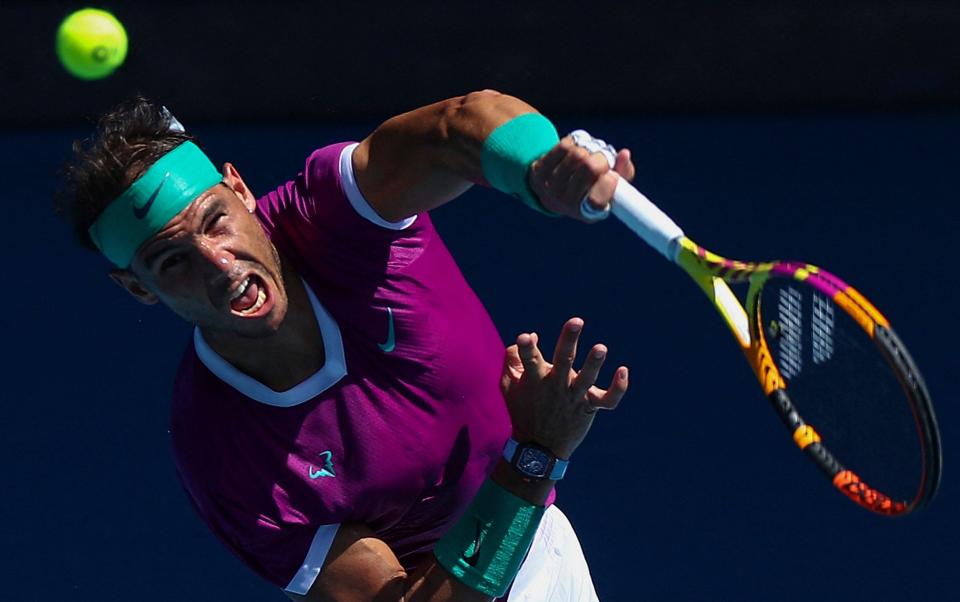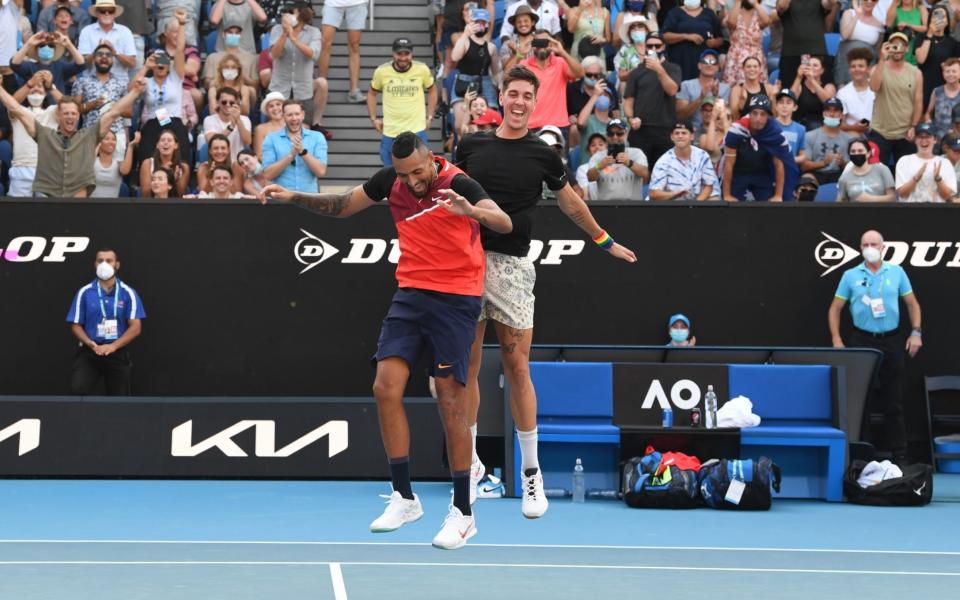Rafael Nadal moves into lead in Race to 21 after reaching Australian Open quarter-finals

Could this Australian Open turn out any worse than it already has for nine-time champion Novak Djokovic? Of course it could. Rafael Nadal needs only three more victories to lift the title and thus reclaim the lead in the great grand-slam derby.
Facing the unconventional Frenchman Adrian Mannarino on Sunday, Nadal had to navigate a half-hour tie-break, the longest of his career. But once he had survived that trial, he waltzed through the remaining two sets for a 7-6, 6-2, 6-2 victory.
Nadal did not carry the aura of a potential champion when he arrived in Australia in late December. Indeed, only a couple of weeks earlier, his very presence here had felt uncertain, as he wrestled with the long-term foot injury – a deformed scaphoid – that first surfaced when he was a teenager.
But after romping through the warm-up ATP event that concluded in this same stadium – Rod Laver Arena – Nadal is now on a winning streak of eight matches. And the highest-ranked seed in his quarter of the draw, world No.3 Alexander Zverev, was eliminated on Sunday, further clearing his potential path to glory.
A 21st major title for Nadal would contravene one of tennis’s favourite rules of thumb. This states that if you are away from the tour for x weeks with an injury, it takes you another x weeks of competitive tennis before you regain your peak level. But then, perhaps Nadal does not need to be at his peak to win this event.
The next generation of players continue to underwhelm, even if Daniil Medvedev struck a rare blow for the newcomers when he defeated an overwrought Djokovic in September’s US Open final.
Zverev’s 6-3, 7-6, 6-3 loss to Denis Shapovalov was alarmingly limp and listless, leading the Eurosport pundit Mats Wilander to comment that “there’s not going to be a big four in this generation. There are going to be seven, eight, nine, 10 guys. Sascha [Alexander] Zverev is not going to be dominating like [his predecessors] because emotionally, today, I don’t think he was a top player, to be honest”.
What a fine opportunity, then, for Nadal to lift the Norman Brookes Trophy and move ahead of both Djokovic and Roger Federer on the Open-era leaderboard. And what a turnaround since that three-and-a-half-month lay-off at the end of last season. On Thursday, Nadal had admitted to thoughts of retirement. “Everybody around me had a lot of doubts,” he said. “Not about the Australian Open, but about coming back on the tour because the foot was bothering [me] a lot of days.”
The model for Nadal is surely the 2017 Australian Open, which became known as “the throwback slam” when Nadal met Federer in one singles final, while the Williams sisters faced off in the other. Both men involved in their match had come straight into the tournament after lengthy absences, inverting the aforementioned rule of thumb, and demonstrating that they are made of different stuff to ordinary mortals.

To return to Sunday’s match, Mannarino caused Nadal difficulties early on with his flat, bunted groundstrokes, which he hits with so little backswing that it is difficult to read which way the ball is going.
The tie-break, which Nadal won by a 16-14 scoreline in 28 minutes, was a ripper. John McEnroe, who played his own legendary tie-break against Bjorn Borg in 1981, described it on ESPN as one of the 10 best he had ever seen. But Mannarino seemed to tweak a muscle during one of many magnificent rallies, and later admitted that “I felt a little bit weaker” thereafter.
Nadal was typically measured in his post-match comments. “Knowing from where we are coming, things are going much better than expected,” he said. “But sport changes quickly.”
This last point might also resonate with Djokovic, who, like Federer, stands on 20 career grand slams and will not want to go into the French Open playing catch-up. Djokovic will surely be supporting Shapovalov when the two lefties meet in Tuesday night’s quarter-final.
In the men’s doubles, meanwhile, eighth seeds Jamie Murray and Bruno Soares were eliminated by the 2015 champions here, Fabio Fognini and Simone Bolelli of Italy.
Nick Kyrgios and Thanasi Kokkinakis stoke the fire as they progress to doubles quarter-finals
Melbourne Park witnessed two very different Australian victories on Sunday. While an understated Ashleigh Barty forged on in the women’s singles, the doubles pairing of Nick Kyrgios and Thanasi Kokkinakis won through to the quarter-finals with their usual hoopla.
The so-called “Special Ks” have played their last couple of rounds on the brand-new, 5,000-capacity Kia Arena. At an otherwise under-attended tournament, demand for seats is off the scale. Kyrgios and Kokkinakis feel like tennis’s answer to Bruce Springsteen and the E Street Band, who caused a stampede when they took up residence on Broadway.
On Sunday, the Australians were extended to three sets by a South American pairing – Ariel Behar of Uruguay and Gonzalo Escobar of Ecuador. This was a tight match, but you would hardly have known it from the playful way in which the two Australians interacted with each other, and with the boisterous crowd.
“We are bringing the game to new levels,” Kyrgios boasted in the interview room after the home team’s 6-4, 4-6, 6-4 victory. “I saw the TV ratings up like 45 per cent.”
When asked how the sport could draw in new fans, Kyrgios replied: “Tennis has done a really poor job with accepting personalities in the past. They have only marketed three players for the last decade and now it's caught up with them.”

Kyrgios himself will receive extra attention via the new Netflix documentary – a tennis version of the Formula One series Drive To Survive – which is being filmed in Melbourne this fortnight. And one element of the story may relate to the Croatian fitness trainer who confronted him in the players’ gym after the previous round.
As Kokkinakis explained on Sunday, “It was [Croatian doubles player Mate] Pavic's fitness trainer and he came up and smashed a foam roller against a pole as hard as he can. He came up to Nick and said we were being disrespectful, we were showboating. I think at the end of the day they were a bit salty they lost. We're just trying to entertain the crowd, we're trying to get ourselves and our energy up. It was all aggressive on his part, though, for sure.”
As Kokkinakis finished explaining, Kyrgios leaned into the microphone. In a cheeky aside directed towards the whole Croatian team, he murmured: “Yeah, enjoy the flight out.”
As for Barty, she finally lost her serve after 63 consecutive holds dating back seven matches. Otherwise, though, she was largely untroubled in dismissing the talented young American Amanda Anisimova by a 6-4, 6-3 scoreline. Not that she was crowing about her win afterwards. “I'm tested every single match in different ways, in unique ways from every opponent,” said the reliably uncontroversial Barty.

